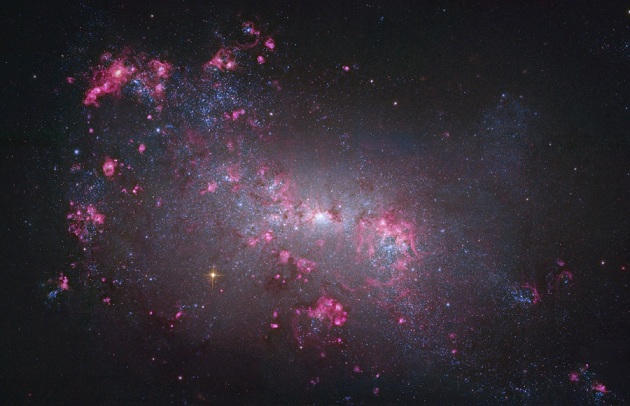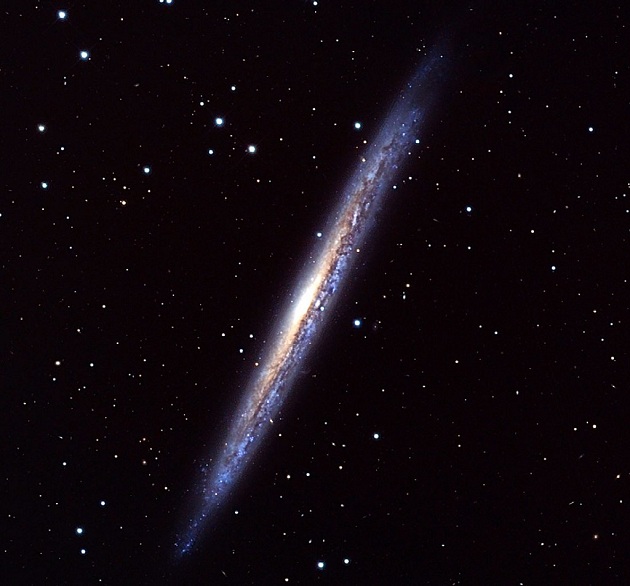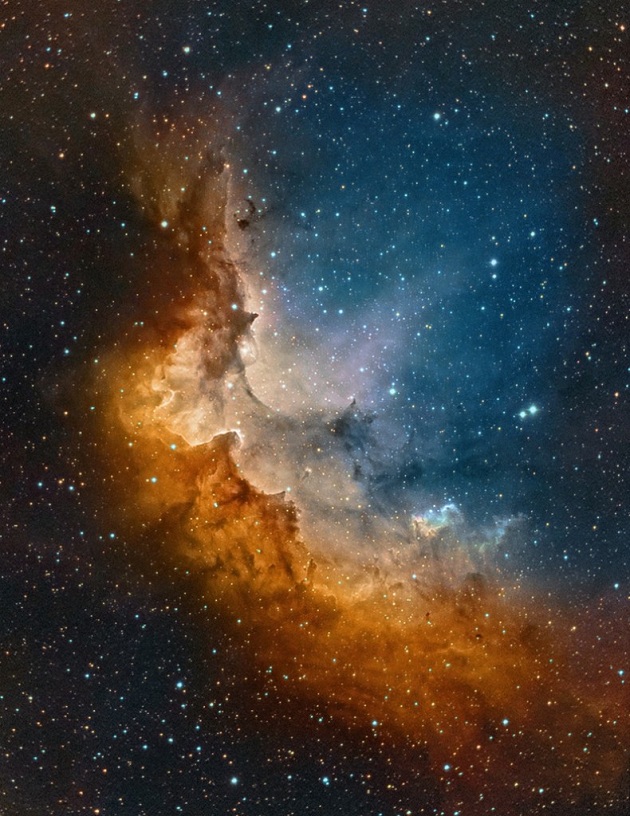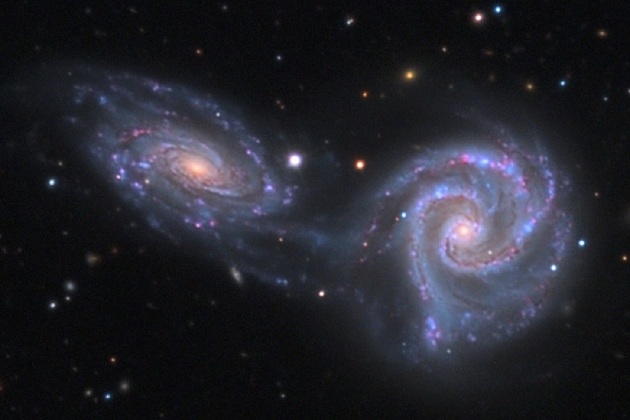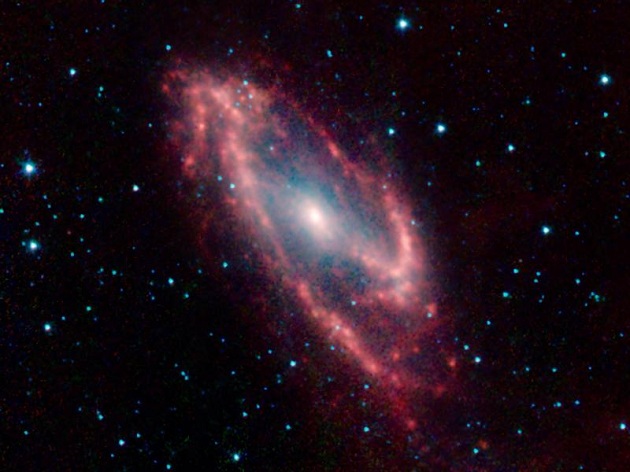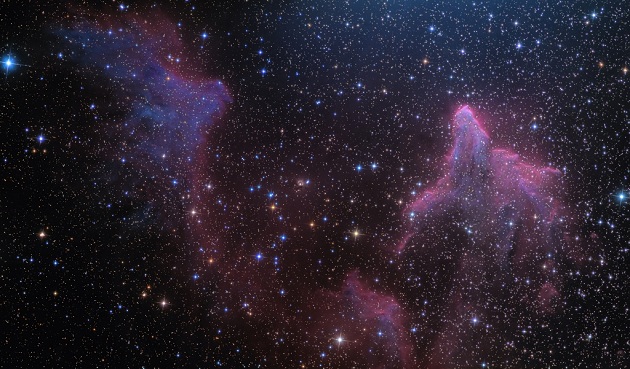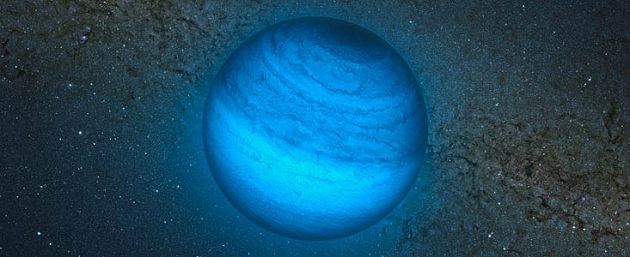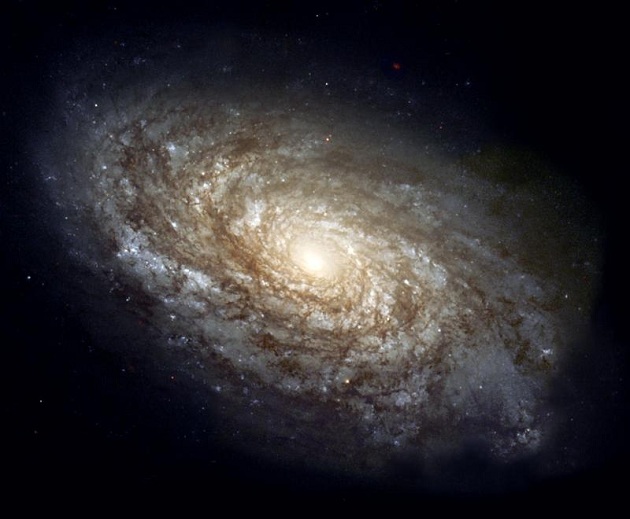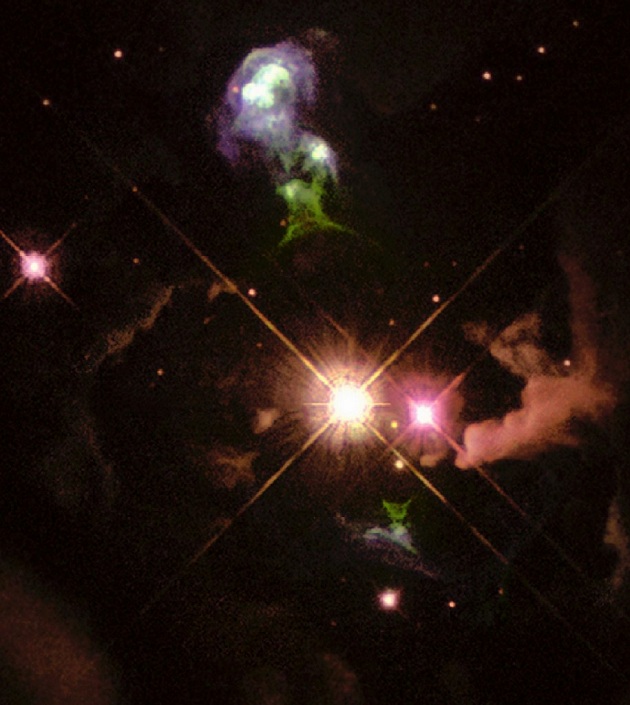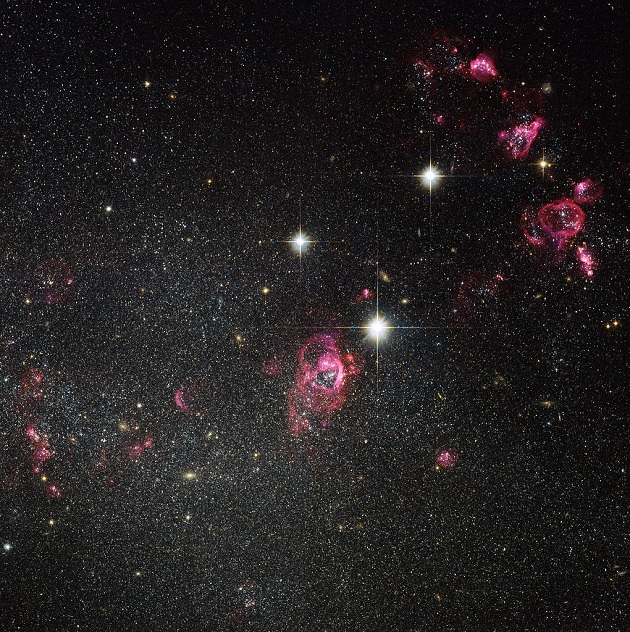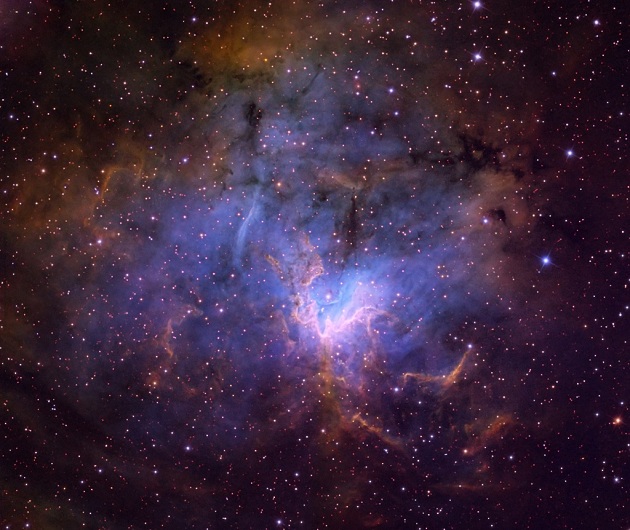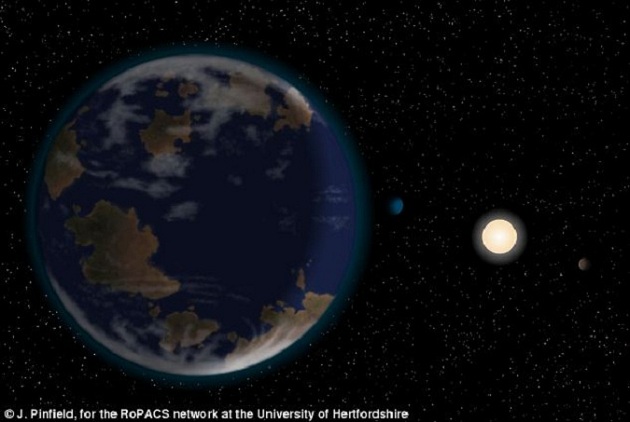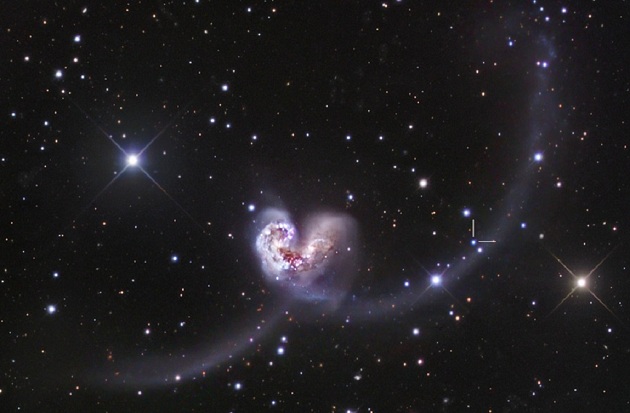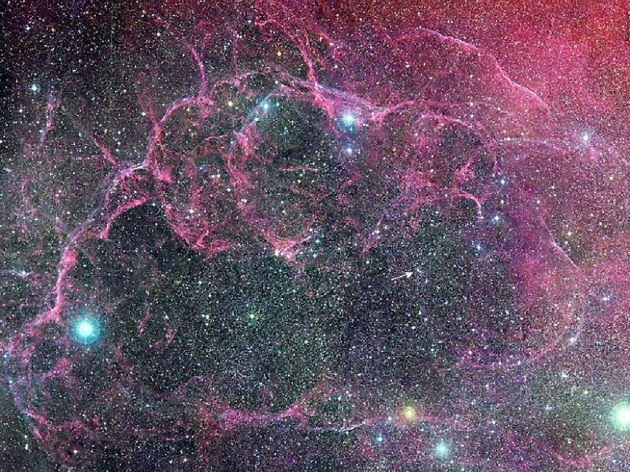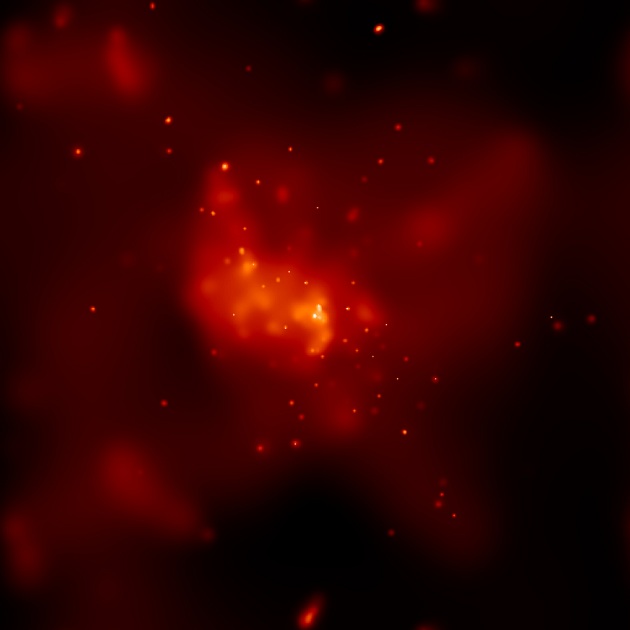
Posts by AnneliesRhemrev:
15 New Planet Candidates in Habitable Zones Discovered
January 8th, 2013By Annelies Rhemrev.
Volunteers from the Planethunters.org website, part of the Oxford University-led Zooniverse project, have discovered 15 new planet candidates orbiting in the habitable zones of other stars.

Artist’s impression of the view from a moon around planet PH2b. Image Credit: Haven Giguere
Added to the 19 similar planets already discovered in habitable zones, where the temperature is neither too hot nor too cold for liquid water, the new finds suggest that there may be a ‘traffic jam’ of all kinds of strange worlds in regions that could potentially support life.
Rather than being seen directly, the new planet candidates were found by Planethunters.org volunteers looking for a telltale dip in the brightness as planets pass in front of their parent stars. One of the 15, a Jupiter-sized planet orbiting a Sun-like star, has been officially confirmed as a planet (with 99.9% certainty) after follow-up work done with the Keck telescope in Hawai’i and has been named ‘PH2 b’. It is the second confirmed planet to be found by Planethunters.org.
‘There’s an obsession with finding Earth-like planets but what we are discovering, with planets such as PH2 b, is far stranger,’ said Zooniverse lead Dr Chris Lintott of Oxford University. ‘Jupiter has several large water-rich moons – imagine dragging that system into the comfortably warm region where the Earth is. If such a planet had Earth size moons, we’d see not Europa and Callisto but worlds with rivers, lakes and all sorts of habitats – a surprising scenario that might just be common.’
Planethunters lead scientist Professor Debra Fisher of Yale University said: ‘We are seeing the emergence of a new era in the Planet Hunters project where our volunteers seem to be at least as efficient as the computer algorithms at finding planets orbiting at habitable zone distances from the host stars. Now, the hunt is not just targeting any old exoplanet – volunteers are homing in on habitable worlds.’
Lead author Dr Ji Wang, also of Yale University, said: ‘We can speculate that PH2 b might have a rocky moon that would be suitable for life. I can’t wait for the day when astronomers report detecting signs of life on other worlds instead of just locating potentially habitable environments. That could happen any day now.’
More than 40 volunteers are acknowledged in the paper for their contributions to the work. Among them is Roy Jackson, a 71-year-old retired police officer who lives in Birtley, near Gateshead. He said: ‘It is difficult to put into words, the pleasure, wonderment and perhaps even pride that I have in some small way been able to assist in the discovery of a planet. But I would like to say that the discovery makes the time spent on the search well worth the effort.’
Mark Hadley, an electronics engineer from Faversham, another of the Planet Hunters credited on the paper, said: ‘Now, when people ask me what I achieved last year I can say I have helped discover a possible new planet around a distant star! How cool is that?’
Dr Chris Lintott said: ‘These are planet candidates that slipped through the net, being missed by professional astronomers and rescued by volunteers in front of their web browsers. It’s remarkable to think that absolutely anyone can discover a planet.’
A report of the research has been submitted to the Astrophysical Journal and is released via arxiv.org on Monday 7 January 2013. The paper is entitled ‘Planet Hunters. V. A Confirmed Jupiter-Size Planet in the Habitable Zone and 42 Planet Candidates from the Kepler Archive Data’.
Source: The University of Oxford
Anne’s Image of the Day: NGC 4449
November 25th, 2012By Annelies Rhemrev
November 25, 2012
NGC 4449, a dwarf galaxy in Canes Venatici
Image Credit & Copyright: Robert Gendler (http://www.robgendlerastropics.com)
Click here for a larger image.
NGC 4449 is a dwarf irregular galaxy of some 19,000 light-years across, located about 12.5 million light-years away in the constellation Canes Venatici. It is part of the M94 Group (the Canes Venatici I Group), a galaxy group relatively close to the Local Group (which contains our Milky Way galaxy). It is moving away from us at about 207 kilometers per second.
NGC 4449 is similar in size, shape and brightness, and often compared to, the Large Magellanic Cloud, a satellite galaxy of the Milky Way. Unlike the Large Magellanic Cloud, however, NGC 4449 is considered a starburst galaxy due to its high rate of star formation (twice the one of the LMC).
Its bar consists of a population of stars with an age older than five million years, while the reddish regions in the image are HII regions with embedded ongoing star formation (the reddish emission from heated hydrogen gas is generally a tell-tale sign of active star formation). There are also several large blue star clusters with young, hot and massive stars visible (which will live less than a few hundred million years), some of them near filaments of dust which provide the fuel for future star formation.
Radio wave observations have shown that NGC 4449 is embedded in a huge gaseous halo with a diameter of 14 times the optical one, that show distortions and irregularities likely caused by interactions with nearby galaxies.
A disk like feature and a lopsided arm structure have been found in its halo and are likely the fossil remains of a merger in its remote past. NGC 4449 most likely had an encounter with its irregular companion galaxy, DDO 125 some 500 million years ago.
NGC 4449 also holds the distinction of being the first dwarf galaxy with an identified tidal star stream (not seen in this close-up image) with lots of red giant stars. This star stream represents the remains of a still smaller infalling satellite galaxy, dubbed NGC 4449B, disrupted by gravitational forces and destined to merge with NGC 4449.
This is how galaxies grow: the smaller galaxy is coming in and getting shredded, eventually leaving its stars scattered through the halo of the host galaxy. This particular interaction is called a “stealth merger” because the smaller galaxy NGC 4449B was nearly imperceptible, but has a profound effect on the shape of its partner.
In 2012 astronomers also found a highly flattened globular cluster with two tails of young stars that may be the nucleus of a gas-rich galaxy being disrupted and absorbed by NGC 4449.
With relatively few stars, small galaxies are thought to possess extensive dark matter halos. But since dark matter interacts gravitationally, these observations offer a chance to examine the significant role of dark matter in galactic merger events. These interactions are likely responsible for NGC 4449’s bursts of star formation.
This image is based on observations made with the NASA/ESA Hubble Space Telescope, and obtained from the Hubble Legacy Archive, which is a collaboration between the Space Telescope Science Institute (STScI/NASA), the Space Telescope European Coordinating Facility (ST-ECF/ESA) and the Canadian Astronomy Data Centre (CADC/NRC/CSA).
See more images on Anne’s Astronomy News
Anne’s Image of the Day: The Papillon Nebula
November 24th, 2012By Annelies Rhemrev
November 24, 2012
The Papillon Nebula, a compact H II “blob” in the LMC
Image Credit: M. Heydari-Malayeri (Paris Observatory) et al., ESA and NASA
Click here for a larger image.
The Papillon Nebula (N159-5) is a butterfly-shaped High Excitation Blob (HEB) of less than 2 light-years across within the nebula N159, a turbulent star-forming region of more than 150 light-years across. It is located in the Large Magellanic Cloud, about 170,000 light-years away in the constellation of Dorado.
High Excitation Blobs (HEBs) are compact H II regions, a rare class of ionized nebulae in the Magellanic Clouds. They are characterized by high excitation, small size, high density, and large extinction compared to typical Magellanic Cloud H II regions. These objects are tightly linked to the early stages of massive star formation, when the stars begin to hatch from their parental molecular clouds.
This compact ionized “blob” is buried in the center of the maelstrom of glowing gases and dark dust in N159. This image shows unprecedented details of the structure and internal morphology of the Papillon nebula (“Papillon” is French for “butterfly”).
A possible explanation of its bipolar shape is the outflow of gas by strong stellar winds from newborn massive stars (over 10 times the mass of our Sun), hidden in the central absorption zone. Such stars are so hot that their radiation pressure halts the infall of gas and directs it away from the stars in two opposite directions. Presumably, a dense equatorial disk formed by matter still trying to fall in onto the stars focuses the outstreaming matter into the bipolar directions.
It is rather rare that we can see massive stars so early after their birth.
This image was taken on September 5, 1998 with the Wide Field Planetary Camera 2 onboard the Hubble Space Telescope.
See more images on Anne’s Astronomy New
Anne’s Image of the Day: NGC 5907
November 23rd, 2012By Annelies Rhemrev
November 23, 2012
NGC 5907, an edge-on spiral galaxy in Draco
This image has been obtained from the Wikimedia Commons.
Click here for a larger image.
NGC 5907 (nicknamed Splinter Galaxy, Draco’s Needle and The Knife Edge) is a warped spiral galaxy of about 150,000 light-years across, located some 53.5 million light years away in the northern constellation of Draco, while it is moving away from us at approximately 667 kilometers per second. It is a member of the NGC 5866 Group of galaxies.
This galaxy is seen almost perfectly edge-on from our line of sight. We see a very flat disk, laced with dark dust lanes, that appears extraordinarily elongated.
NGC 5907 has an anomalously low metallicity, meaning that it has very few chemical elements other than hydrogen and helium. It contains few detectable giant stars, being apparently composed almost entirely of dwarf stars. In 1940, a supernova exploded in this galaxy, designated SN 1940A.
NGC 5907 has long been considered a prototypical example of a warped spiral in relative isolation. Then in 2006, an international team of astronomers announced the presence of extended tidal streams of stars surrounding the galaxy what may be the cause for the warp. But, even though NGC 5907 is a member of a galactic group, there are no galaxies near enough to it to be causing an interaction which could account for its streamers of stars.
The arcing tidal streams form tenuous loops (which are not seen in this image) extending more than 150,000 light-years from the narrow, edge-on galaxy. Recorded only in very deep exposures, these streams were likely formed when two galaxies collided.
Previously, researchers had thought that the stellar swirls were formed when a smaller galaxy hit a larger one, but a new study shows that this would have been impossible. In order to produce the observed streams, two roughly equally-sized galaxies crashed into each other 8 or 9 billion years ago. Simulations also showed that the galaxies must have been rich in gas in order to produce the swirls.
The Milky Way is heading for a crash into Andromeda in 4.5 billion years, and the resulting galaxy could have a similar shape. Most large spiral galaxies are thought to have formed in a similar process.
This image is created using the 24 inch telescope on Mt. Lemmon, AZ.
See more images on Anne’s Astronomy News
Anne’s Image of the Day: The Wizard Nebula
November 22nd, 2012By Annelies Rhemrev
November 22, 2012
The Wizard Nebula, a nebula surrounding the star cluster NGC 7380
Image Credit & Copyright: J-P Metsävainio (http://astroanarchy.zenfolio.com)
Click here for a larger image.
The Wizard Nebula (Sharpless 142 or SH2-142 for short) is a diffuse nebula surrounding the developing open star cluster NGC 7380. It spans about 140 × 75 light-years and lies within our Milky Way Galaxy, about 7,200 light years away in the constellation of Cepheus. It is moving toward us at 34.13 kilometers per second.
The name Sharpless comes from a catalog of 312 emission nebulae (H II regions). The first edition was published by Stewart Sharpless in 1953 with 142 objects (Sh1) and the second and final version was published in 1959 with 312 objects (Sh2).
This kind of nebulae are the birthplace of stars. They are formed when very diffuse molecular clouds begin to collapse under their own gravity, often due to the influence of a nearby supernova explosion. The cloud collapses and fragments, sometimes forming hundreds of new stars. The newly-formed stars ionize the surrounding gas to produce an emission nebula.
In this case, the stars of NGC 7380 have emerged from its natal cloud some 5 million years or so ago, making it a relatively young cluster. And, although the nebula may last only a few million years, some of the stars being formed may outlive our Sun.
The Wizard Nebula is ionized by the binary star HD215835 (DH Cephei), together with the many young energetic stars within the cluster. They make the nebula that surrounds them glow and their winds and radiation sculpt clouds of gas and dust into the mountainous ridges seen here.
This bright, active star-forming region is part of a much larger molecular cloud in Cepheus, called NGC 7380E, which total mass is estimated to be 6000-15000 solar masses.
This image was created in HST-palette (HST=Hubble Space Telescope) from the emission of ionized elements, R=Sulfur, G=Hydrogen and B=Oxygen.
See more images on Anne’s Astronomy News
Anne’s Image of the Day: Arp 271
November 21st, 2012By Annelies Rhemrev
November 21, 2012
Arp 271, a pair of interacting galaxies in Virgo
Image Credit & Copyright: Adam Block/Mount Lemmon SkyCenter/University of Arizona (http://www.caelumobservatory.com/index.html)
Click here for a larger image.
Arp 271 is a pair of interacting spiral galaxies: NGC 5426 (the more oblique galaxy at left) and NGC 5427 (the nearly face-on spiral galaxy at right). Together they are about 130,000 light-years across and located some 90 million light-years away towards the constellation of Virgo.
The galaxies are in the throes of a slow but disturbing interaction, that began likely a several million years ago. These twin galaxies — which have similar sizes, masses, structures, and shapes with expansive arms and a compact core – appear undisturbed. But the mutual pull of gravity has already begun to alter and distort their visible features.
The gravity between the interacting galaxies has begun to pull some of the outer stars towards the center creating a bridge of stars. This intergalactic bridge acts like a feeding tube, allowing the twins to share gas and dust with one other across the 60,000 light years of space separating them.
Colliding gases caused by the interaction also triggered bursts of star formation in each galaxy. Star-forming, or HII, regions appear as hot pink knots that trace out the spiral patterns in each galaxy. The giant ones in NGC 5426 are more abundant on the side of the galaxy closest to NGC 5427. Starburst activity can also be seen in the galaxy’s connecting bridge.
Likewise, the giant HII regions in NGC 5427’s disk are forming at a high rate and are plentiful. One giant star-forming region at the tip of NGC 5427’s western spiral arm, looks especially large and disturbed, as does the arm itself, which is unusually straight, as if strong tidal forces have broken the arm in two, causing it to bleed starlight.
It is not certain that the interaction between the two galaxies of Arp 271 will end in a collision and ultimately a merging of the two galaxies, although the galaxies have already been affected. This dramatic dance will last for tens of millions of years, creating new stars as a result of the mutual gravitational attraction between the galaxies.
Once thought to be unusual and rare, gravitational interactions between galaxies are now known to be quite common (especially in densely populated galaxy clusters) and are considered to play an important role in galaxy evolution. Most galaxies have probably had at least one major, if not many minor, interactions with other galaxies since the advent of the Big Bang.
Quite possibly, our own Milky Way will undergo a similar collision in about five billion years with the neighbouring Andromeda galaxy, which is now located about 2.6 million light-years away from the Milky Way.
See more images on Anne’s Astronomy News
Anne’s Image of the Day: Maffei 2
November 17th, 2012By Annelies Rhemrev
November 17, 2012
Maffei 2, a barred spiral galaxy in Cassiopeia
Image Credit: NASA/JPL-Caltech/UCLA
Click here for a larger image
Maffei 2 (also known as UGCA 39) is a, heavily obscured, intermediate barred spiral galaxy of about 15,000 light-years across, located near the Galactic Plane, some 9.8 million light-years away in the constellation Cassiopeia, far behind — but seemingly next to — the Heart Nebula (IC 1805). It is a member of the IC 342/Maffei Group, the group of galaxies that is the closest to the Local Group. This galaxy is approaching us at roughly 17 kilometers per second.
It lies in the “Zone of Avoidance”, the area of the sky that is obscured by interstellar dust, gas and stars in our own Milky Way, and is about 99.5 percent obscured by these dust clouds. As a result Maffei 2, is barely detectable at optical wavelengths, and is, therefore, discovered from its infrared emission only in 1968 by Paolo Maffei, together with its elliptical neighbour Maffei 1.
This infrared image from the Spitzer Space Telescope penetrates the dust to reveal the galaxy in all its glory. It clearly shows the unusual structure of Maffei 2, with a strong central bar and prominent dusty, asymmetric spiral arms. It contains billions of stars, and also harbors a burst of star formation in its very core (one of the nearest examples of this process). These structural asymmetries, as well as its nuclear starburst, are possibly caused by an ongoing merger with a small satellite companion galaxy.
See more images on Anne’s Astronomy News
Anne’s Image of the Day: Messier 15
November 16th, 2012By Annelies Rhemrev
November 16, 2012
Messier 15, a globular cluster in Pegasus
Image Credit: ESA/Hubble & NASA
Click here for a larger image.
Messier 15 (also designated NGC 7078) is a globular cluster of about 175 light-years across, located some 33,600 light-years away in the constellation Pegasus (The Flying Horse). Over 12 billion years old, it is one of the oldest known globular clusters, but is rich and bright despite its age. The cluster is approaching us at roughly 107 kilometers per second.
A globular cluster is a spherical conglomeration of old stars that formed together from the same cloud of gas, found in the outer reaches of the Milky Way in a region known as the halo and orbiting the Galactic Centre.
Home to over 100,000 stars, Messier 15 has a total luminosity of 360,000 times that of the Sun; its brightest stars have a luminosity of 1,000 times that of our Sun. It contains a large number of variable stars (112) and pulsars (9), including one double neutron star system. It is also the first globular cluster known to harbour a planetary nebula, and it is still one of only four globulars known to do so. The planetary nebula, called Pease 1, can be seen in this image as a small blue blob to the lower left of the globular’s core.
Messier 15 is perhaps the densest of all globulars in our Milky Way galaxy. The cluster has undergone a process of contraction called “core collapse”, in which gravitational interactions between stars led to many members of the cluster migrating towards the center, which is quite common in the dynamical evolution of globulars (about 20% of the globular clusters have undergone a core collapse).
This central core is extremely small compared to the cluster, only about 1.4 light-years, and half of the stars of the cluster are packed in a central sphere with a radius of just 10 light-years. It is still unclear if the central core of M15 is packed so dense simply because of the mutual gravitational interaction of the stars it is made of, or if it houses a central medium-mass black hole. In that case it would be among the nearest and better observable to us, being only little more remote than the Galactic Center and much less obscured by interstellar matter.
Messier 15 can be seen with the naked eye under very good conditions and can be observed with binoculars or a small telescope, appearing as a fuzzy star. Telescopes with a larger aperture (at least 6 in./150 mm diameter) will start to reveal individual stars, the brightest of which are of magnitude +12.6.
This image was created from images taken with the Wide Field Channel of Hubble’s Advanced Camera for Surveys.
See more images on Anne’s Astronomy News
Comments Off on Anne’s Image of the Day: Messier 15
Anne’s Image of the Day: IC 59 and IC 63
November 15th, 2012By Annelies Rhemrev
November 15, 2012
IC 59 and IC 63, two arc-shaped nebulae in Cassiopeia
Image Credit & Copyright: Ken Crawford, Rancho Del Sol Observatory (http://www.imagingdeepsky.com)
Click here for a larger image.
IC 59 (left) and IC 63 (right) are a combination of faint, arc-shaped emission and reflection nebulae, located about 600 light-years away in the constellation Cassiopeia. Together they are approximately 10 light-years across.
The bluish glow shinning down from the top comes from the intense radiation of the bright, hot star Gamma Cassiopeia that is located only 3 to 4 light-years from the nebulae, and which may also have shed this nebulous material into the space around it. The edges of the nebulae glow brightly from this intense radiation that is slowly evaporating and lighting up these flowing shapes of gas and dust.
Gamma Cassiopeia is with a radius of 14 times our Sun, 55,000 times more luminous, 19 times more massive, and rotates at about 300 kilometers per hour, or 150 times more rapidly than the Sun. It is known as an eruptive blue-white subgiant variable star. (Eruptive variable stars vary in brightness because of violent processes and flares in their coronae and chromospheres.)
This star is an erratic variable that reached a maximum brightness in 1937, but then unexpectedly dropped in surface temperature from 12,000°K to 8500°K. It is encircled by a surrounding gaseous disk of material thrown off by its rapid rotation, that radiates the emissions. Mass loss is apparently related to the brightness variations.
IC 63 — the brighter of the two and slightly closer to Gamma Cassiopeia than IC 59 — is a combination of an emission and reflection nebula. Unlike a reflection nebula which appears blue, the glowing hydrogen gas appears red. IC 59 is primary a refection nebula, showing much less red hydrogen, and is appearing blue of dust reflected starlight that is passing through it.
See more images on Anne’s Astronomy News
Exoplanet Lost in Space…
November 14th, 2012By Annelies Rhemrev.
Orphaned world may help to explain how planets and stars form
Astronomers using ESO’s Very Large Telescope and the Canada-France-Hawaii Telescope have identified a body that is very probably a planet wandering through space without a parent star. This is the most exciting free-floating planet candidate so far and the closest such object to the Solar System at a distance of about 100 light-years. Its comparative proximity, and the absence of a bright star very close to it, has allowed the team to study its atmosphere in great detail. This object also gives astronomers a preview of the exoplanets that future instruments aim to image around stars other than the Sun.
This artist’s impression shows the free-floating planet CFBDSIR J214947.2-040308.9. This is the closest such object to the Solar System. It does not orbit a star and hence does not shine by reflected light; the faint glow it emits can only be detected in infrared light. Here we see an artist’s impression of an infrared view of the object with an image of the central parts of the Milky Way from the VISTA infrared survey telescope in the background. The object appears blueish in this near-infrared view because much of the light at longer infrared wavelengths is absorbed by methane and other molecules in the planet’s atmosphere. In visible light the object is so cool that it would only shine dimly with a deep red colour when seen close-up. Image Credit: ESO/L. Calçada/P. Delorme/Nick Risinger (skysurvey.org)/R. Saito/VVV Consortium
Free-floating planets are planetary-mass objects that roam through space without any ties to a star. Possible examples of such objects have been found before [1], but without knowing their ages, it was not possible for astronomers to know whether they were really planets or brown dwarfs — “failed” stars that lack the bulk to trigger the reactions that make stars shine.
But astronomers have now discovered an object, labelled CFBDSIR2149 [2], that seems to be part of a nearby stream of young stars known as the AB Doradus Moving Group. The researchers found the object in observations from the Canada-France-Hawaii Telescope and harnessed the power of ESO’s Very Large Telescope to examine its properties [3].
The AB Doradus Moving Group is the closest such group to the Solar System. Its stars drift through space together and are thought to have formed at the same time. If the object is associated with this moving group — and hence it is a young object — it is possible to deduce much more about it, including its temperature, mass, and what its atmosphere is made of [4]. There remains a small probability that the association with the moving group is by chance.
The link between the new object and the moving group is the vital clue that allows astronomers to find the age of the newly discovered object [5]. This is the first isolated planetary mass object ever identified in a moving group, and the association with this group makes it the most interesting free-floating planet candidate identified so far.

This closeup of an image captured by the SOFI instrument on ESO’s New Technology Telescope at the La Silla Observatory shows the free-floating planet CFBDSIR J214947.2-040308.9 in infrared light. This object, which appears as a faint blue dot at the centre of the picture, is the closest such object to the Solar System. It does not orbit a star and hence does not shine by reflected light; the faint glow it emits can only be detected in infrared light. The object appears blueish in this near-infrared view because much of the light at longer infrared wavelengths is absorbed by methane and other molecules in the planet’s atmosphere. In visible light the object is so cool that it would only shine dimly with a deep red colour when seen close-up. Image Credit: ESO/P. Delorme
“Looking for planets around their stars is akin to studying a firefly sitting one centimeter away from a distant, powerful car headlight,” says Philippe Delorme (Institut de planétologie et d’astrophysique de Grenoble, CNRS/Université Joseph Fourier, France), lead author of the new study. “This nearby free-floating object offered the opportunity to study the firefly in detail without the dazzling lights of the car messing everything up.”
Free-floating objects like CFBDSIR2149 are thought to form either as normal planets that have been booted out of their home systems, or as lone objects like the smallest stars or brown dwarfs. In either case these objects are intriguing — either as planets without stars, or as the tiniest possible objects in a range spanning from the most massive stars to the smallest brown dwarfs.
“These objects are important, as they can either help us understand more about how planets may be ejected from planetary systems, or how very light objects can arise from the star formation process,” says Philippe Delorme. “If this little object is a planet that has been ejected from its native system, it conjures up the striking image of orphaned worlds, drifting in the emptiness of space.”
These worlds could be common — perhaps as numerous as normal stars [6]. If CFBDSIR2149 is not associated with the AB Doradus Moving Group it is trickier to be sure of its nature and properties, and it may instead be characterised as a small brown dwarf. Both scenarios represent important questions about how planets and stars form and behave.
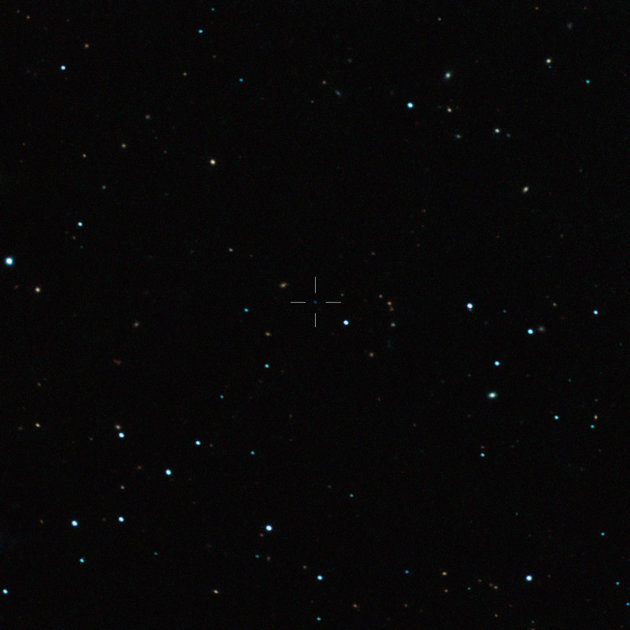
This image captured by the SOFI instrument on ESO’s New Technology Telescope at the La Silla Observatory shows the free-floating planet CFBDSIR J214947.2-040308.9 in infrared light. This object, which appears as a faint blue dot at the centre of the picture and is marked with a cross, is the closest such object to the Solar System. It does not orbit a star and hence does not shine by reflected light; the faint glow it emits can only be detected in infrared light. The object appears blueish in this near-infrared view because much of the light at longer infrared wavelengths is absorbed by methane and other molecules in the planet’s atmosphere. In visible light the object is so cool that it would only shine dimly with a deep red colour when seen close-up. Image Credit: ESO/P. Delorme
“Further work should confirm CFBDSIR2149 as a free-floating planet,” concludes Philippe Delorme. “This object could be used as a benchmark for understanding the physics of any similar exoplanets that are discovered by future special high-contrast imaging systems, including the SPHERE instrument that will be installed on the VLT.”
Notes
[1] Numerous candidates for these kinds of planets have been found before (with corresponding press releases and papers, e.g. from Science Magazine, Nature, Royal Astronomical Society). These objects started to become known in the 1990s, when astronomers found that the point at which a brown dwarf crosses over into the planetary mass range is difficult to determine. More recent studies have suggested that there may be huge numbers of these little bodies in our galaxy, a population numbering almost twice as many as the main sequence stars present.
[2] The object was identified as part of an infrared extension of the Canada-France Brown Dwarfs Survey (CFBDS), a project hunting for cool brown dwarf stars. It is also referred to as CFBDSIR J214947.2-040308.9.
[3] The team observed CFBDSIR2149 with both the WIRCam camera on the Canada France Hawaii Telescope on Hawaii, and the SOFI camera on the ESO New Technology Telescope in Chile. The images taken at different times allowed the object’s proper motion across the sky to be measured and compared to members of the AB Doradus Moving Group. The detailed study of the object’s atmosphere was made using the X-shooter spectrograph on ESO’s Very Large Telescope at the Paranal Observatory.
[4] The association with the AB Doradus Moving Group would pin down the mass of the planet to approximately 4–7 times the mass of Jupiter, with an effective temperature of approximately 430 degrees Celsius. The planet’s age would be the same as the moving group itself — 50 to 120 million years.
[5] The team’s statistical analysis of the object’s proper motion — its angular change in position across the sky each year — shows an 87% probability that the object is associated with the AB Doradus Moving Group, and more than 95% probability that it is young enough to be of planetary mass, making it much more likely to be a rogue planet rather than a small “failed” star. More distant free-floating planet candidates have been found before in very young star clusters, but could not be studied in detail.
[6] These free-floating objects can also reveal their presence when they pass in front of a star. The light travelling towards us from the background star is bent and distorted by the gravity of the object, causing the star to suddenly and briefly brighten — a process known as gravitational microlensing. Microlensing surveys of the Milky Way, such as OGLE, may have detected free-floating planets in this way (for example, a Microlensing Experiment published in Nature in 2011).
This research is presented in a paper, “CFBDSIR2149-0403: a 4-7 Jupiter-mass free-floating planet in the young moving group AB Doradus?” to appear in Astronomy & Astrophysics on 14 November 2012.
Source: The European Southern Observatory (ESO)
Read more stories on Anne’s Astronomy News
Anne’s Image of the Day: The Triangulum Galaxy
November 14th, 2012By Annelies Rhemrev
November 14, 2012
The Triangulum Galaxy, a spiral galaxy in the Local Group
Image Credit & Copyright: Robert Gendler (http://www.robgendlerastropics.com)
Click here for a larger image.
The Triangulum Galaxy (catalogued as Messier 33 or NGC 598) is a spiral galaxy, located approximately 3 million light-years away in the constellation Triangulum. With a diameter of about 50,000 light years (half the diameter of the Milky Way), the Triangulum galaxy is the third largest member of the Local Group (a group of galaxies which also contains the Milky Way, Andromeda and about 30 other smaller galaxies). However, the faintest outlayers seem to reach more far out, so that the true diameter may be some 82 million light-years. It is approaching our Galaxy at 24 kilometers per second.
Triangulum may be home to 40 billion stars, compared to 400 billion for the Milky Way, and 1 trillion (1000 billion) stars for Andromeda. The mass of the Triangulum Galaxy has been estimated between 10 and 40 billion solar masses.
The disk-shaped galaxy, surrounded by a faint halo, has prominent loosely wound arms of gas and dust that spiral out from the nucleus, and dark dust lanes. There is no bulge at the nucleus. The inner part of the galaxy has two luminous spiral arms, along with multiple spurs that connect the inner to the outer spiral features. The main arms are designated IN (north) and IS (south).
Although Triangulum is classified as unbarred, there may be a weak bar-like structure about the galactic nucleus. The nucleus of this galaxy is an H II (star forming) region, and it contains an ultraluminous X-ray source, which is the most luminous source of X-rays in the Local Group. However, the nucleus does not appear to contain a supermassive black hole.
Triangulum appears to be divided into two distinct components with a different star formation history between the inner disk (within a radius of 30 million light-years) and the outer disk and halo, and may be explained by a scenario of “inside-out” galaxy formation. This occurs when gas is accumulated at large radii later in a galaxy’s life space, while the gas at the core becomes exhausted. The result is a decrease in the average age of stars with increasing radius from the galaxy core.
The northern main spiral arm contains four large HII regions, while the southern arm has greater concentrations of young, hot stars. The estimated rate of supernova explosions in the Triangulum Galaxy is one supernova explosion every 147 years, on average. As of 2008, a total of 100 supernova remnants have been identified in the Triangulum Galaxy, and a majority of the remnants lie in the southern half of the spiral galaxy. Similar asymmetries exist for highly luminous concentrations of massive stars. The center of the distribution of these features is offset about two arc minutes to the southwest.
About 54 globular clusters have been identified in this galaxy, but the actual number may be 122 or more. The confirmed clusters may be several billion years younger than globular clusters in the Milky Way, and cluster formation appears to have increased during the past 100 million years. This increase is correlated with an inflow of gas into the center of the galaxy.
At least 112 variables have been discovered in Triangulum, including 4 novae and about 25 Cepheids. In 2007, a black hole about 15.7 times the mass of the Sun was detected in the galaxy. The black hole, named M33 X-7, orbits a companion star which it eclipses every 3.5 days. It is the largest stellar mass black hole known.
Triangulum’s brightest and largest H II region is NGC 604, a diffuse emission nebula containing ionized hydrogen. As seen from Earth, NGC 604 is located northeast of the galaxy’s central core. It is one of the largest H II regions known, with a diameter of nearly 1500 light-years and a spectrum similar to that of the Orion Nebula.
NGC 604, may have undergone a discrete outburst of star formation about three million years ago. Astronomers counted 200 young hot massive stars (of 15 to 60 solar masses) which have recently formed here. This nebula is the second most luminous HII region within the Local Group of galaxies.
Triangulum is also home to the smaller H II regions NGC 588, 592 and 595. Other prominent HII regions in the galaxy include IC 132, IC 133 and IK 53.
One of the small Local Group member galaxies, the Pisces Dwarf (LGS 3), located a little more than 2 million light-years away, lies at a distance of 913 million light-years from both Triangulum and Andromeda. This means it could be a satellite galaxy of either galaxies. The Pisces Dwarf has a core radius of 483 light-years and 26 million solar masses.
Triangulum itself is a remote but gravitationally bound companion of the Andromeda galaxy. The distance of Triangulum from Andromeda is about 750,000 light-years. Triangulum is moving towards the Andromeda Galaxy and a clumpy stream of hydrogen gas and stars is linking Triangulum with Andromeda, what suggests that a past interaction between these two galaxies took place between 2-8 billion years ago, and a more violent encounter 2.5 billion years in the future.
The fate of the Triangulum Galaxy is unclear, but seems to be linked to its larger neighbor Andromeda. Suggested future scenarios for Triangulum range from being torn apart and absorbed by Andromeda fueling it with hydrogen to form new stars or losing all of its gas—thus, the ability to form new stars—to participating in the collision between the Milky Way and Andromeda, most likely ending orbiting the merger remnant of the latter two galaxies and fusing with it much later. Two other possibilities are a collision with the Milky Way before Andromeda arrives or an ejection out of the Local Group.
The Triangulum Galaxy is one of the most distant objects that can be viewed with the naked eye – under exceptionally good viewing conditions with no light pollution. Through a small telescope, the galaxy looks like a diffuse patch about the same size as the full Moon.
See more images on Anne’s Astronomy News
Anne’s Image of the Day: Pulsar SXP 1062
November 13th, 2012By Annelies Rhemrev
November 13, 2012
SXP 1062, a pulsar within a supernova remnant
Image Credit: X-ray: NASA/CXC/Univ.Potsdam/L.Oskinova et al & ESA/XMM-Newton; Optical: AURA/NOAO/CTIO/Univ.Potsdam/L.Oskinova et al
Click here for a larger image.
SXP 1062 is a young pulsar within a supernova remnant of some 744 light years across, located in the Wing of the Small Magellanic Cloud (a small satellite galaxy to our Milky Way), about 180,000 light-years away in the southern constellation of Tucana.
The Wing of the Small Magellanic Cloud is a peripheral region of this small galaxy. The Wing is part of the tidal feature that connects the Small Magellanic Cloud to its neighbour, the Large Magellanic Cloud.
The bubble-shaped feature on the right-hand side of the image is the supernova remnant that encloses the pulsar (the bright white source in the center). The diffuse blue glow at the center represents X-ray emission from both the pulsar and the hot gas that fills the remnant of the supernova.
Optical images show that SXP 1062 is part of a binary system, and that it accretes mass from this stellar companion, a massive, hot, blue star. On the left side in this image (seen in optical light) is a spectacular formation of gas and dust in a star-forming region. (Can someone tell me its name?)
A supernova occurs when a star explodes at the end of its life. After some supernova explosions, when the star collapses and becomes so dense that protons and electrons squish together to form neutrons, there remains a small, ultra-dense neutron star. Rapidly rotating, highly magnetized neutron stars are called pulsars. (After other supernova explosions, a black hole may be left behind.) The explosion throws a large, roughly spherical cloud of dust and hot gas into space surrounding the neutron star (or black hole). When this slams into the existing interstellar medium, it heats up so much it glows in X-rays.
Since supernova remnants shine only for a few tens of thousands of years before dispersing into the interstellar medium, not many pulsars have been detected while still embedded in their expanding shell. This is the first clear example of such a pair in the Small Magellanic Cloud.
SXP 1062 is rotating unusually slowly — about once every 18 minutes, in an extremely long period — 1,062 seconds. (In contrast, some pulsars are found to revolve multiple times per second, including most newly born pulsars.) This relatively leisurely pace of SXP 1062 makes it one of the slowest rotating pulsars in the Small Magellanic Cloud
Since pulsars slow down as they age, SXP 1062’s sluggish rotation seems to imply an advanced age, in contrast to the fairly young age of the supernova remnant (between 10,000 and 40,000 years old) that surrounds it. This means that the pulsar is very young, from an astronomical perspective, since it was presumably formed in the same explosion that produced the supernova remnant. Therefore, assuming that it was born with rapid spin, it is a mystery why SXP 1062 has been able to slow down by so much, so quickly.
This false-colour image combines the X-ray view, based on data from XMM-Newton (blue), with optical data from NOAO’s Cerro Tololo Inter-American Observatory (CTIO), obtained using two special filters that reveal the glow of oxygen (green) and hydrogen (red).
See more images on Anne’s Astronomy News
Anne’s Image of the Day: NGC 4414
November 12th, 2012By Annelies Rhemrev
November 12, 2012
NGC 4414, a dusty spiral galaxy in Coma Berenices
Image Credit: Hubble Heritage Team (AURA/STScI/NASA/ESA)
Click here for a larger image.
NGC 4414 (also known as UGC 7539) is a massive unbarred spiral galaxy of some 56,000 light-years in diameter, located about 62.3 million light-years away in the constellation Coma Berenices, while it is moving away from us at approximately 716 kilometers per second. It is a member of the Coma I group of galaxies, very close to the Virgo Cluster.
NGC 4414 is a typical example of a flocculent galaxy, what means it is patchy, with discontinuous spiral arms (the opposite of a grand design spiral galaxy, which has well-defined spiral arms).
The central regions of this galaxy contain primarily older, yellow and red stars. The outer spiral arms are considerably bluer due to the ongoing formation of young, blue stars — the brightest of which can be seen individually — between which is what appears to be a Luminous Blue Variable. The arms are also very rich in clouds of interstellar dust, seen as dark patches and streaks silhouetted against the starlight.
NGC 4414 is quite isolated in space, without signs of past interactions with other galaxies. The galaxy exhibits a high gas density and therefore is very rich in gas, both neutral hydrogen and molecular hydrogen, of which the neutral hydrogen extends far beyond its optical disk. Despite the high gas density, NGC 4414 is not a starburst galaxy, a fact that could be related to its isolation.
In 1974 a supernova, SN 1974G, was observed which is the only supernova in this galaxy to be recorded so far. But, strangely enough, there is no direct evidence for a supermassive black hole in the center of NGC 4414.
Based on careful brightness measurements of the many Cepheid variable stars in NGC 4414, astronomers were able to make an accurate determination of its distance. Along with similarly determined distances to other nearby galaxies, NGC 4414 contributes to astronomers’ overall knowledge of the expansion rate of the Cosmos, and helps them determine the age of the Universe.
This composite image is obtained with the Hubble Space Telescope in 1995 and 1999, using the Wide Field Planetary Camera 2 through three different color filters.
See more images on Anne’s Astronomy News
Anne’s Image of the Day: Herbig-Haro 32
November 11th, 2012By Annelies Rhemrev
November 11, 2012
Herbig-Haro 32, a bright Herbig–Haro object in Aquila
Image Credit: NASA and The Hubble Heritage Team (AURA/STScI)
Click here for a larger image
Herbig-Haro 32 (HH 32) is a bright Herbig–Haro object located some 960 light-years away in the constellation of Aquila.
A Herbig-Haro object is a small bright nebula in a star-forming region, created when jets of material — at speeds of several hundred kilometres per second — from a newborn star collide with the interstellar medium. The bipolar jets plow into the surrounding nebula, producing strong shock waves that heat the gas and cause it to glow in the light of hydrogen atoms (green) and sulfur ions (blue), several other atoms and ions, and sometimes radiation from the exciting star that is reflected by the surrounding gas (red).
This glow makes it a Herbig-Haro object, in honor of astronomers George Herbig and Guillermo Haro. However, many HH objects don’t show a clearly jet-like morphology and appear as systems of a few scattered, emitting knots. All known Herbig-Haro objects have been found within the boundaries of dark clouds and are strong sources of infrared.
They are transient phenomena, lasting not more than a few thousand years. They can evolve visibly over a few years, as parts of them fade while others brighten as they collide with clumpy material in the interstellar medium.
HH 32 is an excellent example of a Herbig-Haro object, although rather old. The intense wind of material blowing from the bright, young central star (called AS 353A) has already cleared much of the dust out of the central region, thus exposing the star to direct view.
We can still see interstellar gas and dust around the young star, and two oppositely directed jets coming from this star. The end of the optical jet is some 12,000 AU (12,000 times the distance between Earth end the Sun) from the central star. The total length of the bipolar outflow is about 0.54 light-years.
The jet on the top side, whose furthest extent is about 0.2 light-year from the star, is pointed more nearly in our direction, while the opposite jet on the bottom lies on the far side of the star and is fainter either because it is partially obscured by dust surrounding the star or because there is much less material in front of the star.
See more images on Anne’s Astronomy News
Anne’s Image of the Day: Holmberg II
November 10th, 2012By Annelies Rhemrev
November 10, 2012
Holmberg II, a dwarf irregular galaxy in Ursa Major
Image Credit: NASA & ESA
Click here fo a larger image.
Holmberg II (also known as Arp 268 and UGC 4305) is a very bright dwarf irregular galaxy located only about 9.8 million light-years away in the constellation Ursa Major. It is a member of the M81 Group of galaxies, and one of the few that isn’t distracted by gravity from other nearby galaxies.
This small galaxy is a patchwork of dense star-forming regions and extensive barren areas with less material, which can stretch across thousands of light-years.
Holmberg II is dominated by giant bubbles of glowing gas – the largest about 5,500 light-years wide – which are regions of old star formation. The cavities are blown by high-mass stars (as these stars form in dense regions of gas and dust, they expel strong stellar winds that blow away the surrounding material) and of gas by the shock waves produced in supernovae (the violent explosions that mark the end of the lives of massive stars).
As a dwarf galaxy, it has neither the spiral arms of galaxies like the Milky Way nor the dense nucleus of an elliptical galaxy of which the gravitational pull would destroy the fragile bubbles. This makes Holmberg II a gentle haven where these fragile structures can hold their shape.
New star birth is also taking place, but not in the same areas as the bubbles because these are drained now of gas or dust. The star formation regions in Holmberg II appear as massive, disorganized patches filled with hundreds of young, blue stars, that occupy a relatively large fraction of the disk. One region in particular has almost as many young stars as the famous Tarantula Nebula in the Large Magellanic Cloud.
Holmberg II is the perfect example of the “champagne” model of starbirth – where new stars create even newer ones. It works like this: when a bubble is created by stellar winds, it moves outwards until it reaches the edge of the molecular cloud that spawned it. At the exterior edge, dust and gas have been compressed and form a nodule similar to a blister. Here another new star forms.. and triggers again… and triggers again… similar to the chain reaction which happens when you open a bottle of champagne.
The galaxy also hosts an ultraluminous X-ray source in the middle of three gas bubbles in the top right of the image. There are competing theories as to what causes this powerful radiation — one intriguing possibility is an intermediate-mass black hole which is pulling in material from its surroundings.
Holmberg II enables astronomers to study star birth in an environment that isn’t disturbed by density waves (as happens in larger galaxies such as the Milky Way) or by deformation caused by the pull of another galaxy, and that is conveniently close.
This image was captured by the NASA/ESA Hubble Space Telescope. It is a composite of visible and near-infrared exposures taken using the Wide Field Channel of Hubble’s Advanced Camera for Surveys.
See more images on Anne’s Astronomy News
Anne’s Image of the Day: NGC 1491
November 9th, 2012By Annelies Rhemrev
November 9, 2012
NGC 1491, an emission nebula in Perseus
Image Credit & Copyright: Ken Crawford, Rancho Del Sol Observatory (http://www.imagingdeepsky.com)
Click here for a larger image.
NGC 1491 (also designated SH2-206 and LBN 704) is a bright emission nebula and HII region, located on the edge of a vast cloud region of neutral gas, about 10,700 light-years away in the Perseus arm of our Milky Way Galaxy in the constellation Perseus.
HII regions are well known for being places where new stars are born, and are created when ultraviolet radiation from hot stars ionizes the surrounding gas, causing it to glow in visible light. The surrounding dust is also heated by this radiation, so we also see it glow in infrared light.
The blue 11.22 magnitude star, BD +50 ° 886, is illuminating the nebula while its strong stellar wind is “blowing” a bubble in the gas that immediately surrounds it. The intense radiation from the star is also eroding the gas clouds surrounding it.
The entire nebula is quite irregular with a subtle bite cut out of the nebulosity from the east side that creates a darker hollow, and a high surface brightness region — as seen in this image — preceding the star. A faint, elongated haze extends from this patch to the northeast past the star giving an elongated appearance.
This narrowband image of the brighter part of NGC 1491 was processed in the standard Hubble palette.
See more images on Anne’s Astronomy News
Potentially Habitable Exoplanet in our Neighborhood Found
November 8th, 2012By Annelies Rhemrev
An Anglo-German team of astronomers has discovered a new planet orbiting a nearby star at just the right distance for an Earth-like climate that could support life.
This artist’s impression shows HD40307 g in the foreground (on the left hand side), with its host star HD40307 and two other planets in the system (on the right-hand side). Image Credit: J. Pinfield
Located 43 light-years away in the southern constellation Pictor, the orange-colored dwarf star HD 40307 has previously been found to hold three “super-Earth” exoplanets in close orbit. Now, a team of researchers poring over data from ESO’s HARPS (High Accuracy Radial velocity Planet Searcher) has identified what seems to be three new exoplanets in the HD 40307 system.
These new exoplanet candidates, designated with the letters e, f, and g, all appear to be super-Earths as well, with one of them, HD 40307 g, appearing to be orbiting in the star’s “Goldilocks Zone”, the band around a star where temperatures are neither too hot nor too cold for liquid water to exist.
In addition, HD 40307 g is located far enough away from its star not be tidally locked. This means it wouldn’t have one side subject to constant heat and radiation while its other “far side” remains cold and dark, thus avoiding the intense variations in global climate, weather and winds that would come as a result.
“The star HD 40307 is a perfectly quiet old dwarf star, so there is no reason why such a planet could not sustain an Earth-like climate,” said Guillem Angla-Escude from Germany’s University of Goettingen, who led the research with Mikko Tuomi at the University of Hertfordshire in Britain.
If HD 40307 g, with a mass of at least seven times that of Earth, is indeed confirmed, it may very well get onto the official short list of potentially habitable worlds outside our Solar System — although those others are quite a bit closer to the mass of our own planet.
While the other planetary candidates in the HD 40307 system are positioned much more closely to the star, with b, c, d, and e within or at the equivalent orbital distance of Mercury, g appears to be in the star’s liquid-water habitable zone, orbiting at 0.6 AU in an approximately 200-day-long orbit. At this distance the exoplanet receives around 62% of the solar energy as Earth gets from the Sun.

Representation of the liquid water habitable zone around HD 40307 compared to our Solar System. Image Credit: Tuomi et al.
More than 800 planets have been discovered outside our Solar System since the first was detected in the early 1990s, but only a handful of those have been in the habitable zone. Even more rare are planets in the zone that rotate, as this one does, to create a day-time and night-time, which increases the chance of an Earth-like environment. Those that don’t spin are tidally locked, with one half in constant darkness.
“This is the closest one to Earth in a habitable zone that is not tidally locked,” University of Hertfordshire astronomer Hugh Jones said. “Just as Goldilocks liked her porridge to be neither too hot nor too cold but just right, this planet, or indeed any moons that it has, lie in an orbit comparable to Earth, increasing the probability of it being habitable.”
Although news like this is exciting, as we’re always eagerly anticipating the announcement of a true, terrestrial Earth-like world that could be host to life as we know it, it’s important to remember that HD 40307 g is still a candidate—more observations are needed to not only confirm its existence but also to find out exactly what kind of planet it may be.
We have to learn more about its possible atmosphere and life-hosting capabilities. Still, just finding potential Earth-sized worlds in a system like HD 40307′s is a big deal for planetary scientists. This system is not like ours, yet somewhat similar planets have still formed… that in itself is a clue to what else may be out there.
“The planetary system around HD 40307 has an architecture radically different from that of the Solar System… which indicates that a wide variety of formation histories might allow the emergence of roughly Earth-mass objects in the habitable zones of stars”, the team reports.
The astronomers made the discovery, unveiled in a research paper in the journal Astronomy & Astrophysics, by examining data from the HARPS spectrograph, attached to a European Southern Observatory telescope at La Silla in Chile’s Atacama desert.
The HARPS device is able to pick up tiny changes in the color of the light coming from a host star as it wobbles under the gravitational influence of orbiting planets. The team used a novel technique to filter out signals caused by the host star itself. “This significantly increased our sensitivity and enabled us to reveal three new planets around the star,” said Mikko Tuomi.
Sources: Reuters, Universe Today
Read more stories on Anne’s Astronomy News
Anne’s Image of the Day: The Antennae Galaxies
November 8th, 2012By Annelies Rhemrev
November 8, 2012
The Antennae Galaxies, a pair of merging galaxies in Corvus
Image Credit & Copyright: Robert Gendler (http://www.robgendlerastropics.com/)
Click here for a larger image.
The Antennae Galaxies [NGC 4038 (right in this image) and NGC 4039] are a pair of merging galaxies of some 61,000 light-years across (without the tidal tails), located about 45 million light-years away within the NGC 4038 group of galaxies in the southern constellation Corvus (and also visible very low on the southern horizon in the Northern Hemisphere). The Antennae are among the closest known merging galaxies, while they are moving away from us at about 1642 kilometers per second.
The Antennae are in the midst of a galactic collision. About 1.2 billion years ago, the Antennae were two separate galaxies. NGC 4039, the larger of the two before they collided, was an unbarred spiral galaxy and NGC 4038 was a barred spiral galaxy. 900 million years ago, the Antennae began to approach one another, and 600 million years ago, the Antennae passed through each other. 300 million years ago, the Antennae’s stars began to be released from both galaxies. Today the two tidal tails of ejected stars, gas and dust extend out almost 500,000 light years from their respective centers, making them resemble the antennae of an insect, hence the name of the galaxy pair.
Within 400 million years, the Antennae’s nuclei will collide and become a single core with stars, gas, and dust around it. Observations and simulations of colliding galaxies suggest that the Antennae Galaxies will eventually form one giant elliptical galaxy. They give us a preview of what may happen when our Milky Way collides with the neighboring Andromeda galaxy in several billion years.
The galaxies are criss-crossed by filaments of dark brown dust, and dotted by over a thousand bright star clusters, containing tens of thousands of massive, hot, young stars — the result of a burst of star formation triggered by the collision. The brightest and most compact of them are called super star clusters.
Only about 10% of the newly formed super star clusters in the Antennae will live to see their ten millionth birthday. The vast majority of the super star clusters formed during this interaction will disperse, with the individual stars becoming part of the smooth background of the galaxy. It is however believed that about a hundred of the most massive clusters will survive to form regular globular clusters.
The most massive of the massive young stars have already sped through their evolution in a few million years and exploded as supernovae. Two supernovae have been discovered in the Antennae: SN 2004GT and SN 2007sr. The two small, thin lines in this image pinpoint the location of SN 2007sr, a Type Ia supernova that occurred on December 18th, 2007.
A Type Ia supernova is a result from the violent explosion of a white dwarf star. This category of supernovae produces consistent peak luminosity. The stability of this luminosity allows these supernovae to be used as standard candles to measure the distance to their host galaxies because the visual magnitude of the supernovae depends primarily on the distance.
Supernova explosions are enriching the intergalactic gas with elements like oxygen, iron, and silicon that will be incorporated into new generations of stars and planets. In the Antennae, there are also rich deposits of neon, magnesium, and silicon discovered, which are among the elements that form the building blocks for habitable planets.
Although galaxy mergers today are not common, it is believed that in the past they were an important channel of galaxy evolution. Therefore understanding the (physics of) galaxy mergers is a very important task for astrophysicists and cosmologists.
See more images on Anne’s Astronomy News
Anne’s Image of the Day: Vela Supernova Remnant
November 7th, 2012By Annelies Rhemrev
November 7, 2012
Vela Supernova Remnant
Image Credit: NASA/The Hubble Heritage Team (STScI/AURA)
Click here for a larger image.
The Vela Supernova Remnant (R762-0019) is a huge supernova remnant around 100 light-years across, located about 800 light-years away in the southern constellation Vela, what makes it one of the closest known supernova remnants to Earth. The stellar explosion occurred approximately 11,000-12,300 years ago. This was direct observational proof that supernovae can form neutron stars.
The Vela supernova remnant includes the Pencil Nebula (NGC 2736) — and also overlaps the Puppis Supernova Remnant, which is four times more distant. Both the Puppis and Vela remnants are among the largest and brightest features in the X-ray sky.
A supernova occurs when a star explodes in the final phase of its life. The exploding star can become billions of times as bright as the Sun before gradually fading from view. At its maximum brightness, the exploded star may outshine an entire galaxy.
After some supernova explosions, there remains a small, dense star composed mainly of neutrons. Such a star is called a neutron star. Rapidly rotating, highly magnetized neutron stars are called pulsars. (After other supernova explosions, a black hole may be left behind.) The explosion throws a large, roughly spherical cloud of dust and hot gas into space surrounding the neutron star (or black hole). When this slams into the existing interstellar medium, it heats up so much it glows in X-rays
The star in Vela brightened by about 100 million times to rival the Moon as the brightest object in the night sky. Near the centre of the expanding nebula is the Vela pulsar (PSR J0835-4510), a faint, rapidly-spinning neutron star only a few kilometres in diameter, the remnant of the star that exploded. This tiny, massive object spins about 11 times a second.
The Vela supernova explosion was roughly spherical. Non-uniformity of the interstellar medium causes Vela’s appearance to be irregular. The outer layers of the star crashed into the interstellar medium, driving a shock wave that is still visible today. The above image captures much of that filamentary and gigantic shock in visible light.
This close-up image was taken with the Hubble Space Telescope. The little arrow shows the place of the Vela pulsar.
See more images on Anne’s Astronomy News
The Milky Way’s Black Hole is Suddenly Eating a Lot More
November 6th, 2012By Annelies Rhemrev
As black holes go, Sagittarius A* is relatively low-key. The supermassive black hole at the center of our galaxy emits very little energy for its size, giving off roughly as much energy as the Sun, even though it is 4 billion times as massive.
This false-color image shows the central region of our Milky Way Galaxy as seen by Chandra. The bright, point-like source at the center of the image was produced by a huge X-ray flare that occurred in the vicinity of the supermassive black hole at the center of our galaxy. Image Credit: NASA/MIT/F. Baganoff et al.
However, astronomers have observed that nearly once a day, the black hole rouses to action, emitting a brief burst of light before settling back down. It’s unclear what causes such flare-ups, and scientists have sought to characterize these periodic bursts in order to better understand how black holes evolve.
Now a team of scientists from MIT, the University of Amsterdam, the University of Michigan and elsewhere have used NASA’s Chandra X-Ray Observatory to detect the brightest flare ever observed from Sagittarius A*. The flare, recorded 26,000 light years away, is 150 times brighter than the black hole’s normal luminosity. Scientists observed the flare for more than one hour before it faded away. This brief burst of activity, they say, may be a clue to how mature black holes like Sagittarius A* behave.
“We’re learning what black holes do when they’re old,” says Joey Neilsen, a postdoc at MIT’s Kavli Institute for Astrophysics and Space Research. “They’re no young whippersnappers like quasars, but they’re still active, and how they’re active is an interesting question.”
Neilsen and his colleagues published their results recently in The Astrophysical Journal.
A finicky eater
Astronomers detect black holes by the light energy given off as they swallow nearby matter. The centers of newborn galaxies and quasars can appear extremely bright, giving off massive amounts of energy as they devour their surroundings. As black holes age, they tend to slow down, consuming less and appearing fainter in the sky.
“Everyone has this picture of black holes as vacuum sweepers, that they suck up absolutely everything,” says Frederick K. Baganoff, a research scientist at MIT Kavli. “But in this really low-accretion-rate state, they’re really finicky eaters, and for some reason they actually blow away most of the energy.”
To detect such a faint signal, the team reserved observing time on NASA’s Chandra X-Ray Observatory, a giant space-based telescope designed to detect extremely faint objects. The team obtained images of the black hole from Chandra, and utilized the telescope’s High Energy Transmission Gratings Spectrometer (HETGS), an instrument built by MIT physics professor Claude Canizares (now the Institute’s vice president for research and associate provost), to analyze the incoming light.
The onboard spectrometer split the black hole’s X-rays into various wavelengths, much like light passed through a prism. The researchers analyzed the data, and found a spike of 700 photons — which, while small compared with more active galaxies, was 150 times brighter than the black hole’s normal luminosity.
“Suddenly, for whatever reason, Sagittarius A* is eating a lot more,” says Michael Nowak, a research scientist at MIT Kavli. “One theory is that every so often, an asteroid gets close to the black hole, the black hole stretches and rips it to pieces, and eats the material and turns it into radiation, so you see these big flares.”
The great escape
While such events appear to be relatively rare, Nowak suspects that flare-ups may occur more frequently than scientists expect. The team has reserved more than a month of time on the Chandra Observatory to study Sagittarius A* in hopes of identifying more flares, and possibly what’s causing them.
Mark Morris, a professor of astronomy at the University of California at Los Angeles, says that while less luminous flares occur daily, scientists have detected very few events from the black hole as bright as this recent flare-up.
“These bright flares give information on the flaring process that isn’t available with the weaker ones, such as how they fluctuate in time during the flare, how the spectrum changes, and how fast they rise and fall,” Morris says. “The greatest importance of this bright flare may be that it builds up the statistics on the characteristics of strong flares that can eventually be used to [identify] the cause of such flares.”
Even more intriguing to Baganoff is why the black hole emits so little energy. In 2003, he ran the very first observations with the then-new Chandra Observatory, and calculated that, given the amount of gas in its surroundings, Sagittarius A* should be about a million times brighter than it is — a finding that suggested the black hole throws away most of the matter it would otherwise consume. The physics underlying such a phenomenon remain a puzzle that Baganoff and others hope to tease out with future observations.
“We’re really studying the great escape, because most of the gas escapes, and that’s not what we expect,” Baganoff says. “So we’re piecing out the history of the activity of the center of our galaxy.”
Source: Massachusetts Institute of Technology (MIT)
Read more stories on Anne’s Astronomy News



